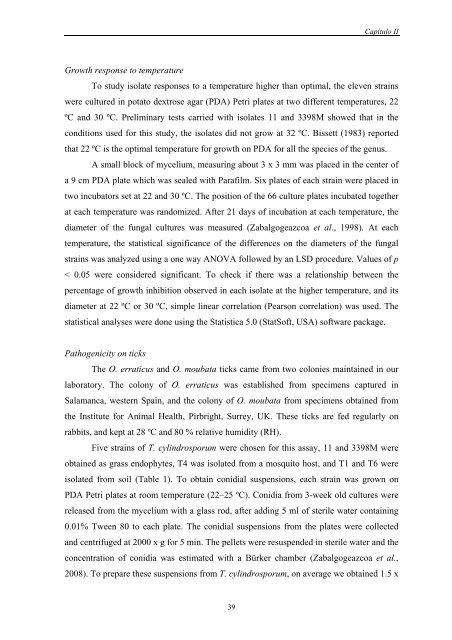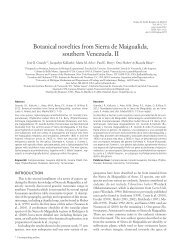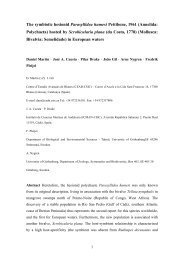TESIS NOEMI HERRERO.pdf - Consejo Superior de Investigaciones ...
TESIS NOEMI HERRERO.pdf - Consejo Superior de Investigaciones ...
TESIS NOEMI HERRERO.pdf - Consejo Superior de Investigaciones ...
Create successful ePaper yourself
Turn your PDF publications into a flip-book with our unique Google optimized e-Paper software.
39<br />
Capítulo II<br />
Growth response to temperature<br />
To study isolate responses to a temperature higher than optimal, the eleven strains<br />
were cultured in potato <strong>de</strong>xtrose agar (PDA) Petri plates at two different temperatures, 22<br />
ºC and 30 ºC. Preliminary tests carried with isolates 11 and 3398M showed that in the<br />
conditions used for this study, the isolates did not grow at 32 ºC. Bissett (1983) reported<br />
that 22 ºC is the optimal temperature for growth on PDA for all the species of the genus.<br />
A small block of mycelium, measuring about 3 x 3 mm was placed in the center of<br />
a 9 cm PDA plate which was sealed with Parafilm. Six plates of each strain were placed in<br />
two incubators set at 22 and 30 ºC. The position of the 66 culture plates incubated together<br />
at each temperature was randomized. After 21 days of incubation at each temperature, the<br />
diameter of the fungal cultures was measured (Zabalgogeazcoa et al., 1998). At each<br />
temperature, the statistical significance of the differences on the diameters of the fungal<br />
strains was analyzed using a one way ANOVA followed by an LSD procedure. Values of p<br />
< 0.05 were consi<strong>de</strong>red significant. To check if there was a relationship between the<br />
percentage of growth inhibition observed in each isolate at the higher temperature, and its<br />
diameter at 22 ºC or 30 ºC, simple linear correlation (Pearson correlation) was used. The<br />
statistical analyses were done using the Statistica 5.0 (StatSoft, USA) software package.<br />
Pathogenicity on ticks<br />
The O. erraticus and O. moubata ticks came from two colonies maintained in our<br />
laboratory. The colony of O. erraticus was established from specimens captured in<br />
Salamanca, western Spain, and the colony of O. moubata from specimens obtained from<br />
the Institute for Animal Health, Pirbright, Surrey, UK. These ticks are fed regularly on<br />
rabbits, and kept at 28 ºC and 80 % relative humidity (RH).<br />
Five strains of T. cylindrosporum were chosen for this assay, 11 and 3398M were<br />
obtained as grass endophytes, T4 was isolated from a mosquito host, and T1 and T6 were<br />
isolated from soil (Table 1). To obtain conidial suspensions, each strain was grown on<br />
PDA Petri plates at room temperature (22–25 ºC). Conidia from 3-week old cultures were<br />
released from the mycelium with a glass rod, after adding 5 ml of sterile water containing<br />
0.01% Tween 80 to each plate. The conidial suspensions from the plates were collected<br />
and centrifuged at 2000 x g for 5 min. The pellets were resuspen<strong>de</strong>d in sterile water and the<br />
concentration of conidia was estimated with a Bürker chamber (Zabalgogeazcoa et al.,<br />
2008). To prepare these suspensions from T. cylindrosporum, on average we obtained 1.5 x

















